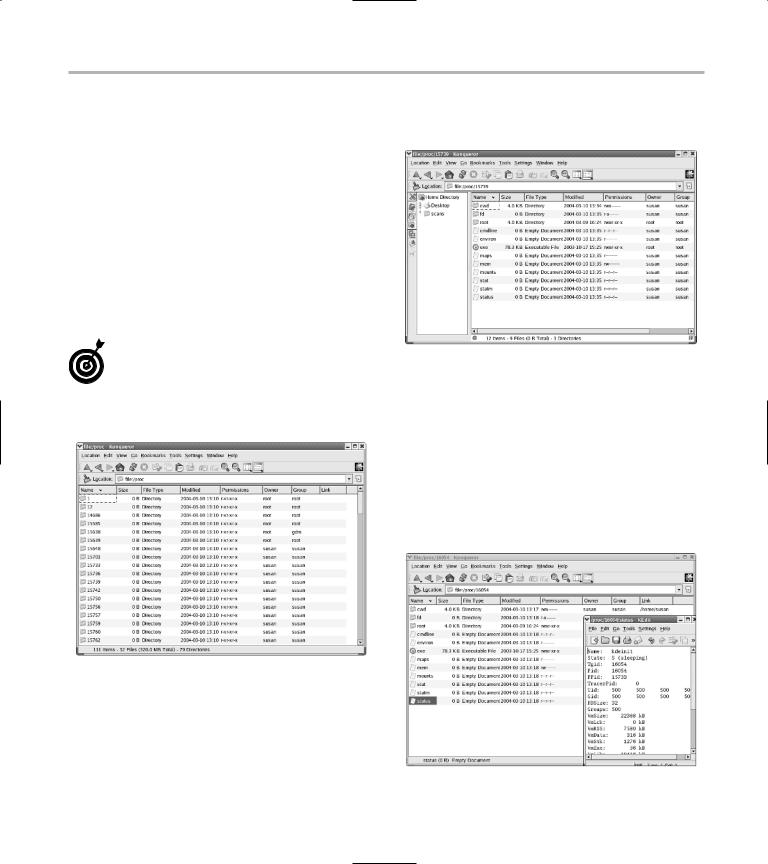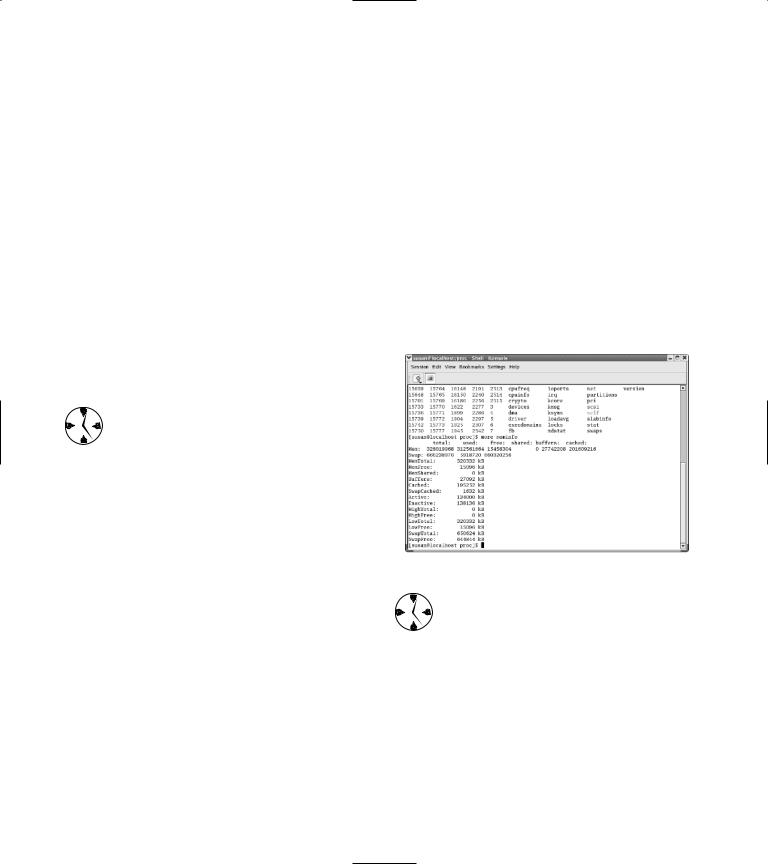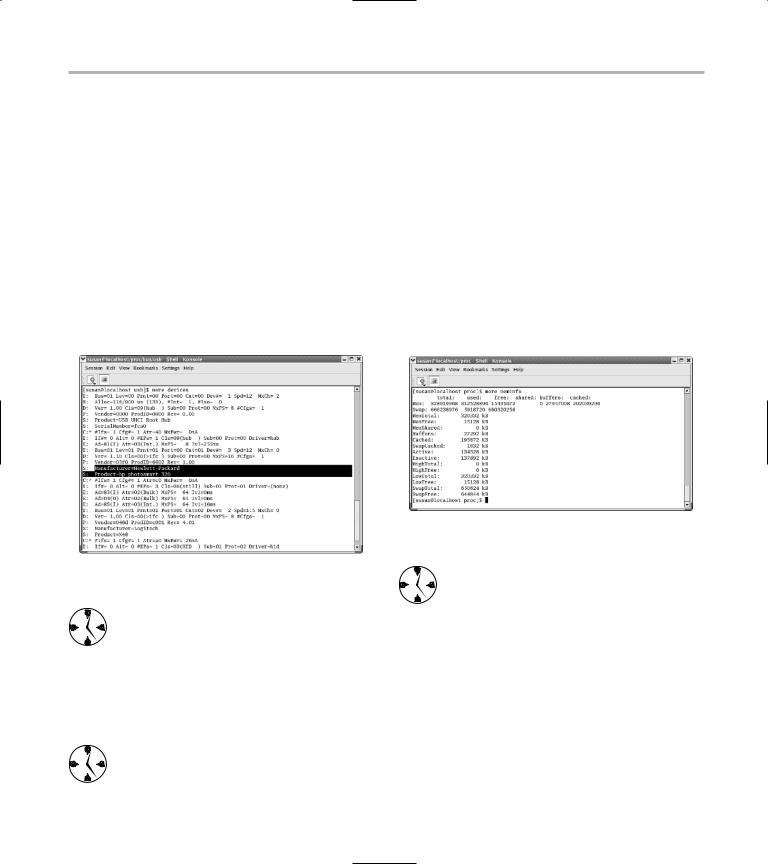
- •Table of Contents
- •Introduction
- •Saving Time with This Book
- •Foolish Assumptions
- •Part I: Making the Desktop Work for You
- •Part II: Getting the Most from Your File System
- •Part III: Good Housekeeping with Linux
- •Part IV: Tweaking the Kernel on Your Linux System
- •Part V: Securing Your Workspace
- •Part VI: Networking Like a Professional
- •Part VII: Monitoring Your System
- •Part VIII: Serving Up the Internet and More
- •Part X: Programming Tricks
- •Part XI: The Scary (Or Fun!) Stuff
- •Icons Used in This Book
- •Discovering Your Protocols
- •Managing Snapshots with the camera: Protocol
- •Remote File Management with fish:
- •Getting Help with help:, info:, and man:
- •Other KDE Protocols
- •Using GNOME VFS Modules
- •Stacking VFS Modules
- •Working with Packages: rpm and rpms
- •Putting VFS to Work at the Command Line
- •Burning CDs with a VFS
- •Skinning Your Desktop with VFS
- •Classifying Data with MIME
- •Creating KDE File Associations
- •Creating New MIME Types with GNOME
- •Making Basic Prompt Transformations
- •Adding Dynamically Updated Data to Your Prompt
- •Colorizing Your Prompt
- •Seeing a Red Alert When You Have Superuser Privileges
- •Saving Your Work
- •Completing Names Automatically
- •Using the Escape Key to Your Advantage
- •Customizing Completion for Maximum Speed
- •Using cd and ls to Navigate through bash
- •Setting Your CDPATH Variables to Find Directories Fast
- •Streamlining Archive Searches
- •Turning the Output of a Command into a Variable with $( )
- •Using $UID and $EUID in Shell Scripts
- •Customizing Variables for Rapid Transit
- •Finding the Right Shell Script
- •Choosing your victims
- •Timing is everything
- •Cleaning up made easy
- •Changing prototype scripts
- •Customizing Your Autostart File
- •Navigating the History List
- •Scrolling
- •Summoning a command by number
- •Searching through history
- •Customizing the History List
- •Adjusting key default settings
- •Filtering the history list
- •Executing Commands Quickly with History Variables
- •Viewing Your Aliases
- •Using Aliases for Complex Commands
- •Automating Tedious Tasks with Functions
- •Filtering file searches by file type
- •Automatic downloading
- •Monitoring Your System in a Snap
- •Un-tarring the Easy Way
- •What Is Samba?
- •Getting Up and Running with Samba
- •Checking whether Samba is installed
- •Enabling Samba
- •Adjusting the workgroup name and creating user accounts
- •Giving a Windows machine access to your home directory
- •Sharing Linux files and directories with other computers
- •Hooking Everyone Up to the Printer
- •Sharing Linux printers with SWAT
- •Using a Windows printer from Linux
- •Plugging In to Remote Data with Linux Programs Quickly
- •Finding Files with locate
- •Finding Files with find
- •Qualifying Your Search with the find Command
- •Doing updated filename searches
- •Adding time-based qualifications
- •Filtering by file size
- •Perusing commonly used qualifications
- •Acting on What You Find
- •Displaying specific info with -printf
- •Checking disk usage by user
- •Executing commands with find
- •Building Complex Commands with xargs
- •Creating Archives with File Roller
- •Inspecting and Extracting Archives with File Roller
- •Adding Functionality to tar with Complex Commands
- •Building archives from the command line
- •Archiving complex search results
- •Backing up an installed package
- •Uprooting Entire Directory Trees with scp
- •Splitting Big Files into Manageable Chunks
- •Building Software from Downloaded tarballs
- •Compiling a tarball: The basic steps
- •Downloading and compiling SuperKaramba
- •Versatile Downloading with wget
- •Mirroring sites with wget
- •Verifying your bookmarks with wget
- •Downloading files with wget
- •Downloading and unpacking in one quick step
- •Downloading and Uploading with curl
- •Setting Up ADIOS
- •Downloading ADIOS
- •Burning ADIOS to CD
- •Installing ADIOS
- •Finding Your Way around UML
- •Connecting to the Internet from an ADIOS VM
- •Using a GUI with UML
- •Installing Software into UML
- •Merging Changes to Your Prototype
- •Querying RPM Packages for Content
- •Digesting Information
- •Creating a Package Index
- •Querying for Prerequisites
- •Dissecting an RPM Package
- •Using RPM at the Command Line
- •Removing RPMs
- •Flagging Down RPM
- •Getting Graphic with RPM
- •Using Rpmdrake to install from media
- •Installing from your Konqueror browser
- •Verifying Your System
- •Reading the Tamper-Proof Seal
- •Setting Up Synaptic and apt in a Snap
- •Keeping Up-to-Date with apt and Synaptic: The Basics
- •Handy Hints about Synaptic
- •Changing repositories
- •Viewing package details
- •Installing new packages with Synaptic
- •Importing the Keys to the Repository
- •Letting Task Scheduler Work for You
- •Scheduling a new task
- •Editing a task
- •Adding environment variables
- •Reining In Resources with Disk Quotas
- •Installing the quota RPM package
- •Enabling file system quotas
- •Getting your files together
- •Setting quotas
- •Reviewing your quotas
- •Using System Accounting to Keep Track of Users
- •Setting up system accounting
- •Looking up user login hours
- •Checking out command and program usage
- •Running Down the Runlevels
- •Runlevel basics
- •Customizing runlevels in Fedora
- •Customizing runlevels in SuSE
- •Customizing runlevels in Mandrake
- •Customizing runlevels at the command line
- •Switching to a new runlevel
- •Disabling Unused Services
- •Removing Unneeded Services
- •Learning about modules
- •Installing a module with insmod
- •Taking care of dependencies automatically with modprobe and depmod
- •Loading a module for a slightly different kernel with insmod and modprobe
- •Removing modules with rmmod
- •Step 1: Making an Emergency Plan, or Boot Disk
- •Step 2: Finding the Source Code
- •Step 4: Customizing the Kernel
- •Step 5: Building the Kernel
- •Understanding the Principles of SELinux
- •Everything is an object
- •Identifying subjects in SELinux
- •Understanding the security context
- •Disabling or Disarming SELinux
- •Playing the Right Role
- •Exploring the Process-Related Entries in /proc
- •Surveying Your System from /proc
- •Popping the Cork: Speeding Up WINE with /proc
- •Reading and Understanding File Permissions
- •Controlling Permissions at the Command Line
- •Changing File Permissions from a Desktop
- •Encryption Made Easy with kgpg and the KDE Desktop
- •Creating keys with kgpg
- •Sharing your key with the world
- •Importing a public key from a public-key server
- •Encrypting and decrypting documents with drag-and-drop ease
- •Encrypting Documents with gpg at the Command Line
- •Sharing a secret file
- •Creating a key pair and receiving encrypted documents
- •Encrypting documents on your home system
- •Encrypting E-Mail for Added Security
- •Encrypting with Ximian Evolution
- •Setting up Mozilla e-mail for encryption
- •Sending and receiving encrypted messages with Mozilla mail
- •Using Cross-Platform Authentication with Linux and Windows
- •Prepping for cross-platform authentication
- •Setting up cross-platform authentication
- •Using PAM and Kerberos to Serve Up Authentication
- •Establishing synchronized system times
- •Testing your domain name server (DNS)
- •Setting up a Key Distribution Center
- •Setting up automatic ticket management with Kerberos and PAM
- •Adding users to the Key Distribution Center
- •Building Good Rules with PAM
- •Phase
- •Control level
- •Module pathname
- •Arguments
- •Dissecting a Configuration File
- •Skipping a Password with PAM
- •Feeling the Power
- •Gaining Superuser Privileges
- •Pretending to Be Other Users
- •Limiting Privileges with sudo
- •Installing sudo
- •Adding Up the Aliases
- •Adding Aliases to the sudo Configuration File
- •Defining the Alias
- •Creating a User_Alias
- •Creating a Runas_Alias
- •Simplifying group managment with a Host_Alias
- •Mounting and unmounting CDs without the superuser password
- •Managing access to dangerous commands with command aliases
- •Using SSH for Top-Speed Connections
- •Setting Up Public-Key Authentication to Secure SSH
- •Generating the key pair
- •Distributing your public key
- •Passing on your passphrase
- •Logging In with SSH and Key Authentication
- •Starting from the command line
- •Getting graphic
- •Creating Shortcuts to Your Favorite SSH Locations
- •Copying Files with scp
- •Secure (And Fast) Port Forwarding with SSH
- •Finding Your Firewall
- •Setting up a simple firewall in Mandrake Linux
- •Setting up a simple firewall in Fedora Linux
- •Setting up a simple firewall in SuSE Linux
- •Editing the Rules with Webmin
- •Starting a Webmin session
- •Reading the rules with Webmin
- •Changing the rules
- •Editing existing rules
- •Adding a new rule with Webmin
- •Sharing Desktops with VNC
- •Inviting Your Friends to Use Your Desktop
- •Serving Up a New Desktop with VNC Server
- •Using tsclient to View Remote Desktops from Linux
- •Using tsclient with a VNC server
- •Using tsclient with an RDP server
- •Creating New VNC Desktops on Demand
- •Switching display managers in SuSE Linux
- •Switching display managers in Mandrake Linux
- •Connecting gdm and VNC
- •Exploring Your Network with lsof
- •Running lsof
- •Interpreting the lsof output
- •Reading file types
- •Discovering Network Connections
- •Other Timesaving lsof Tricks
- •Packet Sniffing with the Ethereal Network Analyzer
- •Starting Ethereal
- •Capturing packets
- •Applying filters to screen packets
- •Peeking in packets
- •Color-coding packets coming from your network
- •Getting Up and Running with Nessus
- •Installing programs Nessus needs to run
- •Installing Nessus
- •Adding a user to Nessus
- •Generating a certificate
- •Starting the daemon and the interface
- •Reading the grim results
- •Keeping Your Plug-ins Up-to-Date
- •Chatting in the Fedora Chat Room
- •Looking for Answers in the SuSE Chat Room
- •Processing Processes with procps
- •Using ps to filter process status information
- •Viewing ps output the way you want to see it
- •Making parent-child relationships stand out in a ps listing
- •Climbing the family tree with pstree
- •Finding processes with pgrep
- •Killing Processes with pkill
- •Killing Processes with killall
- •Closing Windows with xkill
- •Managing Users and Groups with the Fedora/Mandrake User Manager
- •Adding new users
- •Modifying user accounts
- •Adding groups
- •Filtering users and groups
- •Managing Users and Groups with the SuSE User Administrator
- •Adding new users
- •Modifying user accounts
- •Adding groups
- •Filtering users and groups
- •Adding and deleting log files from the viewer
- •Setting up alerts and warnings
- •Viewing your log files from SuSE
- •Monitoring your log files from SuSE
- •Customizing Your Log Files
- •Keeping an Eye on Resources with KDE System Guard
- •Finding and killing runaway processes
- •Prioritizing processes to smooth a network bottleneck
- •Watching your system load
- •Creating a new worksheet
- •Creating system resource logs
- •Displaying network resources
- •Using Synaptic to download and install Apache
- •Installing Apache from disc
- •Starting the Apache Service
- •Building a Quick Web Page with OpenOffice.org
- •Taking Your Site Public with Dynamic DNS
- •Understanding how dynamic DNS works
- •Setting up dynamic DNS
- •Updating your IP address
- •Installing the Fedora HTTP Configuration tool
- •Putting the HTTP Configuration tool to work
- •Watching Your Web Server Traffic with apachetop
- •Installing apachetop
- •Running and exiting apachetop
- •Navigating apachetop
- •Switching among the log files (or watching several at once)
- •Changing the display time of apachetop statistics
- •Accessing MySQL Control Center features
- •Viewing, managing, and repairing a database with the Databases controls
- •Putting the Server Administration controls to work
- •Adding a new user
- •Watching Your MySQL Traffic with mtop
- •Gathering all the packages that mtop needs
- •Installing mtop
- •Monitoring traffic
- •Building a MySQL Server
- •Installing the necessary packages
- •Starting the MySQL server
- •Replicating MySQL Data
- •Configuring replication: The three topologies
- •Setting up replication for a single slave and master
- •Choosing a Method to Back Up MySQL Data
- •Backing Up and Restoring with mysqldump
- •mysqldump backup options
- •Backing up multiple databases
- •Compressing the archive
- •Restoring a mysqldump archive
- •Making a mysqlhotcopy of Your Database
- •Archiving a Replication Slave
- •Taking Care of Business with MySQL Administrator
- •Installing MySQL Administrator
- •Starting MySQL Administrator
- •Choosing an SSL Certificate
- •Creating a Certificate Signing Request
- •Creating a Signing Authority with openssl
- •Creating a certificate authority
- •Signing a CSR
- •Exploring Your Certificate Collection with Mozilla
- •Introducing hotway
- •Getting Started with hotway
- •Setting Up Evolution to Read HTTPMail Accounts with hotway
- •Ringing the Bells and Blowing the Whistles: Your Evolution Summary Page
- •Installing SpamAssassin
- •Installing from the distribution media
- •Installing from RPM downloads
- •Starting the service
- •Fine-Tuning SpamAssassin to Separate the Ham from the Spam
- •Customizing settings
- •Saving your settings
- •Adding a New Filter to Evolution
- •Serving Up a Big Bowl of the RulesDuJour
- •Registering Your Address
- •Taming a Sendmail Server
- •Tweaking Your Configuration Files with Webmin
- •Serving up mail for multiple domains
- •Relaying e-mail
- •Using aliases to simplify mail handling
- •Deciding What to Archive
- •Choosing Archive Media
- •Tape drives
- •Removable and external disk drives
- •Removable media
- •Optical media (CDs and DVDs)
- •Online storage
- •Choosing an Archive Scheme
- •Full backups
- •Differential backups
- •Incremental backups
- •Incremental versus differential backups
- •Choosing an Archive Program
- •Estimating Your Media Needs
- •Creating Data Archives with tar
- •Backing up files and directories
- •Backing up account information and passwords
- •Targeting bite-sized backups for speedier restores
- •Rolling whole file systems into a tarball
- •Starting an Incremental Backup Cycle
- •Restoring from Backup with tar
- •Backing Up to CD (Or DVD) with cdbackup
- •Creating the backup
- •Restoring from a CD or DVD backup
- •Restoring from a disc containing multiple archives
- •Combining the Power of tar with ssh for Quick Remote Backups
- •Testing the ssh connection to the remote host
- •Creating a tar archive over the ssh connection
- •Backing up to tape drives on remote machines
- •Backing Up to a Remote Computer with rdist and ssh
- •Testing the ssh connection to the remote host
- •Creating the distfile
- •Backing up
- •Getting Started with CVS
- •Checking whether CVS is installed
- •Discovering what to use CVS for
- •Creating a CVS Repository
- •Populating Your Repository with Files
- •Simplifying CVS with cervisia
- •Installing cervisia
- •Putting files in your sandbox
- •Adding more files to your repository
- •Committing your changes
- •Browsing your log files
- •Marking milestones with tags
- •Branching off with cervisia
- •Using the libcurl Library (C Programming)
- •Uploading a File with a Simple Program Using libcurl
- •Line 7: Defining functions and data types
- •Line 14: Calling the initialization function
- •Lines 18– 21: Defining the transfer
- •Line 23: Starting the transfer
- •Line 26: Finishing the upload
- •Installing the Ming Library
- •Building a Simple Flash Movie with Ming
- •Examining the program
- •Compiling the program
- •Running the program
- •Building Interactive Movies with Ming
- •Examining the program
- •Compiling the program
- •Running the program
- •Doing the curl E-shuffle with PHP
- •Combining PHP with curl and XML: An overview
- •Checking out the XML file
- •Downloading and displaying the XML file with a PHP script (and curl)
- •Sending E-Mail from PHP When Problems Occur
- •Debugging Perl Code with DDD
- •Installing and starting DDD
- •Examining the main window
- •Reviewing and stepping through source code
- •Making Stop Signs: Using Breakpoints to Watch Code
- •Setting a breakpoint
- •Modifying a breakpoint
- •Opening the data window
- •Adding a variable to the data window
- •Changing the display to a table
- •Using the Backtrace feature
- •Using the Help menu
- •Making Fedora Distribution CDs
- •Downloading the ISO images
- •Verifying the checksums
- •Burning an ISO File to Disc at the Command Line
- •Finding the identity of your drive
- •Running a test burn
- •Burning the distribution discs
- •Burning CDs without Making an ISO First
- •Finding setuid quickly and easily with kfind
- •Finding setuid and setgid programs at the command line
- •Deciding to Turn Off setuid or setgid
- •Changing the setuid or setgid Bit
- •Who Belongs in Jail?
- •Using UML to Jail Programs
- •Using lsof to Find Out Which Files Are Open
- •Debugging Your Environment with strace
- •Investigating Programs with ltrace
- •Handy strace and ltrace Options
- •Recording Program Errors with valgrind
- •Hardening Your Hat with Bastille
- •Downloading and installing Bastille and its dependencies
- •Welcome to the Bastille
- •Addressing file permission issues
- •Clamping down on SUID privileges
- •Moving on to account security
- •Making the boot process more secure
- •Securing connection broker
- •Limiting compiler access
- •Limiting access to hackers
- •Logging extra information
- •Keeping the daemons in check
- •Securing sendmail
- •Closing the gaps in Apache
- •Keeping temporary files safe
- •Building a better firewall
- •Port scanning with Bastille
- •Turning LIDS On and Off
- •Testing LIDS before Applying It to Your System
- •Controlling File Access with LIDS
- •Hiding Processes with LIDS
- •Running Down the Privilege List
- •Getting Graphical at the Command Line
- •Getting graphical in GNOME
- •Getting graphical with KDE
- •Staying desktop neutral
- •Index

26 Finding Out about Your System with
Technique /proc
Save Time By
Using /proc to examine the processes currently running on your system
Exploring your system resources and devices with /proc
Tightening security with
/proc
Getting your kernel to recognize native Windows programs
The /proc file system is a virtual file system full of files representing the current state of your Linux kernel. The files in /proc don’t really exist on disk; rather, they’re collections of data that can be viewed
and navigated just like real files. If you look at the modification time for the files in /proc, you’ll see that the date is always current. That’s accurate because the content of each file is being created on demand as you view it.
You can discover a lot about your system by viewing the contents of the files in /proc. Every process running on your system has a directory in /proc. Each process directory is full of subdirectories and files that contain tidbits of data about the process. Because the information is broken down into small pieces, you can search quickly for just what you need to know about a process.
The /proc file system also contains information about system resources — such as memory usage, CPU usage, and system statistics. The files are constantly being updated, so the information you get from /proc is always current. /proc also maintains information files about all the devices on your network. You can use this information to help debug troublesome new devices.
Using the /proc file system to manipulate the state of the kernel is a real timesaver. Instead of using complex arguments to adjust your kernel, the /proc file system gives you easy access to many of the kernel’s variables. You can tighten security with just a few variable settings, and improve on an existing firewall in no time.
In this technique, we introduce you to /proc, and show you some subtle but effective (and quick) changes you can make to the kernel that will make your system safer and save you a few keystrokes in the long run.
Exploring the Process-Related Entries in /proc
Every process running on your system has its own directory in the /proc file system. You can use the files in the process directory to identify the

Exploring the Process-Related Entries in /proc |
171 |
processes running on your system. You can discover who’s running the process, what command line arguments started the process, and what files that process currently has open.
The directory name for each process is taken from the process ID. For example, the directory that contains information about process 1 (the init process) is named /proc/1. To view the process directory, follow these steps:
1. Open the Konqueror Web browser.
2. Type file:/proc in the Location field and press Enter.
Press the F9 key to close Konqueror’s navigation panel and buy more screen real estate for the directories and files in /proc.
You’re treated to a view of the contents of the /proc directory, as shown in Figure 26-1.
•Figure 26-1: Viewing /proc in Konqueror.
3.For the best view of the /proc directory, choose View View Mode Detailed List View.
The directories with numerical names contain information about the processes currently running on your system (the directory name corresponds to the process number).
4. Double-click a process directory to view the directory contents (see Figure 26-2).
• Figure 26-2: The contents of a process directory.
Table 26-1 lists the files and directories where you can find some interesting information about
a process.
5.To view the contents of any file in the process directory, right-click the filename and choose Open With from the pop-up menu.
6.Enter kedit in the Open With field and click OK.
kedit opens, displaying the file contents, as shown in Figure 26-3.
• Figure 26-3: Exposing the status file with kedit.

172 |
Technique 26: Finding Out about Your System with /proc |
TABLE 26-1: PROCESS-RELATED DIRECTORIES IN THE /PROC FILE SYSTEM |
|
Directory |
What You Find |
|
|
cwd |
The cwd directory is a symbolic link to the current working directory of the process (the directory named in |
|
the Link column). If you’re running a bash shell and your current working directory is /tmp, /proc/$$/cwd is a |
|
symbolic link to /tmp ($$ is a shell variable that contains your process ID). |
fd |
The fd directory contains one entry for each open file. Like cwd, the files in the fd subdirectory are symbolic |
|
links to the open files. File descriptor 0 is connected to the standard input stream for the process, descriptor 1 |
|
is connected to the standard output stream, and descriptor 2 is connected to the standard error stream. |
cmdline |
Open the cmdline file with kedit to view the command line arguments that started the process. |
environ |
Open the environ file to view the environment variables used by the process. |
mounts |
Open the mounts file to view a list of currently mounted devices in use by the process. |
status |
The status file keeps running statistics about the current process. |
|
|
7. When you’re done exploring the file contents, close the editor window.
If you check the Remember Application Association for This Type of File box when you open a file with kedit, you can just doubleclick to open future files with the editor.
If you prefer working at the command line (or you don’t have a graphical interface handy), you can use the more command to display the contents of files within the process directory:
1. Open a terminal window and move into the process directory.
2. Display the file you want to read with the following command:
$ more filename
The contents of the file are displayed in the terminal window, as shown in Figure 26-4.
3. Press the spacebar to see the next page of data.
Whether you get information with kedit or at the command line, you can find lots of handy information about the processes on your system with /proc.
• Figure 26-4: Exposing the status file with more.
If you go to /proc/self, you’ll find it contains a symbolic link to the process you’re running. Look in the Link column for the process ID. Be aware that /proc/self is pretty shifty. If you use a command like ls to look at the /proc/ self directory and then look at it again with another tool, it changes. /proc/self magically points to whichever process opens it.
Surveying Your System from /proc
Files that contain configuration information for devices connected to your computer are scattered

Surveying Your System from /proc |
173 |
throughout the /proc file system. The /proc file system also contains files full of information about system resources. To find the device or system resource information on your system, you may need to do some exploring, but we show you some good places to start.
A few of the files in /proc that relate directly to hardware and system resources are worth mentioning:
/proc/bus/usb: This file contains information about USB (Universal Serial Bus) devices currently plugged into your system. In this file, you find a rundown of the mice, cameras, and serial storage devices currently connected to your computer, as shown in Figure 26-5.
might contain information that helps a newsgroup member determine the cause of your problem.
/proc/cpuinfo: This file contains a collection of information about the system’s CPU. This is the place to look for all the really geeky details about your CPU.
/proc/crypto: The /proc/crypto file contains information about the current encryption algorithms and digital signature tools installed on your system.
/proc/meminfo: This file contains a wealth of information about your system’s memory resources, as shown in Figure 26-6.
• Figure 26-5: Viewing the currently connected USB devices.
If you’re having trouble getting a camera or scanner to work, look here first to be sure that the device is properly connected and identified.
/proc/scsi/scsi: This file contains information about any SCSI devices currently attached to your system. Check it out if you’re having trouble getting a SCSI device to work.
If you’re having device driver problems and decide to appeal to a newsgroup for help, include the information you find in the /proc file corresponding to the device. The /proc file
• Figure 26-6: Checking out the status of the system’s memory.
If your system performance is bad, check out the /proc/meminfo file to find out if you’re running short on memory.
/proc/filesystems: This file contains information about the file system types that can be mounted on your system. Check out /proc/ filesystems to find out what kind of drives you can mount on your system. If ntfs isn’t in the list, you can’t mount Windows drives on your Linux machine.
/proc/uptime: You trivia buffs out there will enjoy this one. This first number in this file is the length of time the system has been running (in seconds), and the second number is the number of seconds that the system has been idle.

174 Technique 26: Finding Out about Your System with /proc
Divide the number of seconds idle by the uptime, and you’ll find out the percentage of time that your system is running without being used. If you have extra CPU time to share, get in touch with setiathome.ssl.berkeley.edu to share the wealth.
Closing Down Security
Gaps with /proc
With just a few quick changes to the files in /proc, you can make a good firewall even better. The Linux kernel includes a number of variables that affect system security. The variables receive their default settings when the kernel is built, but you can customize them to tighten up your security even more. With a little help from /proc, you don’t need to completely rebuild your kernel to take advantage of some of these optional benefits; you can tweak the running kernel with the variables in /proc.
Any changes you make in the /proc files will revert back to the stored kernel configuration when you reboot your system. To make the changes take effect every time you reboot, you can create a startup script (or modify an existing one) to apply the changes automatically.
By making changes to the kernel variables, you can close security gaps that are commonly left open in most kernels. The changes in our example won’t keep out every hacker or shut down all denial-of- service requests, but they’re a good place to start.
If you are running Fedora or Mandrake, you can change the settings of the kernel variables at startup, by following these steps:
1. Open a terminal window and give yourself superuser privileges with the su command.
2. Move to the /etc/rc.d directory:
# cd /etc/rc.d
3. Open the rc.local file with your favorite editor (we’re using kedit):
# kedit rc.local
4.Add the following lines of code to the end of the rc.local file:
echo 1 > /proc/sys/net/ipv4/icmp_echo_ ignore_broadcasts
echo 1 > /proc/sys/net/ipv4/conf/*/log_ martians
echo 0 > /proc/sys/net/ipv4/conf/*/ accept_redirects
5.Save the changes and close the editor.
6.Reboot your system to make the changes take effect.
If you’re a SuSE user, you need to make the same additions, but to a different file. Follow these steps to change your kernel variables at startup:
1. Open a terminal window and give yourself superuser privileges with the su command.
2. Move to the /etc/init.d directory:
#cd /etc/init.d
3.Open the boot.local file with your favorite editor (we’re using kedit):
#kedit boot.local
4.Add the following lines of code to the end of the boot.local file:
echo 1 > /proc/sys/net/ipv4/icmp_echo_ ignore_broadcasts
echo 1 > /proc/sys/net/ipv4/conf/*/log_ martians
echo 0 > /proc/sys/net/ipv4/conf/*/ accept_redirects
5.Save the changes and close the editor.
6.Reboot your system to make the changes take effect.
The three variables we’ve changed tighten your network security a bit. They are as follows:
